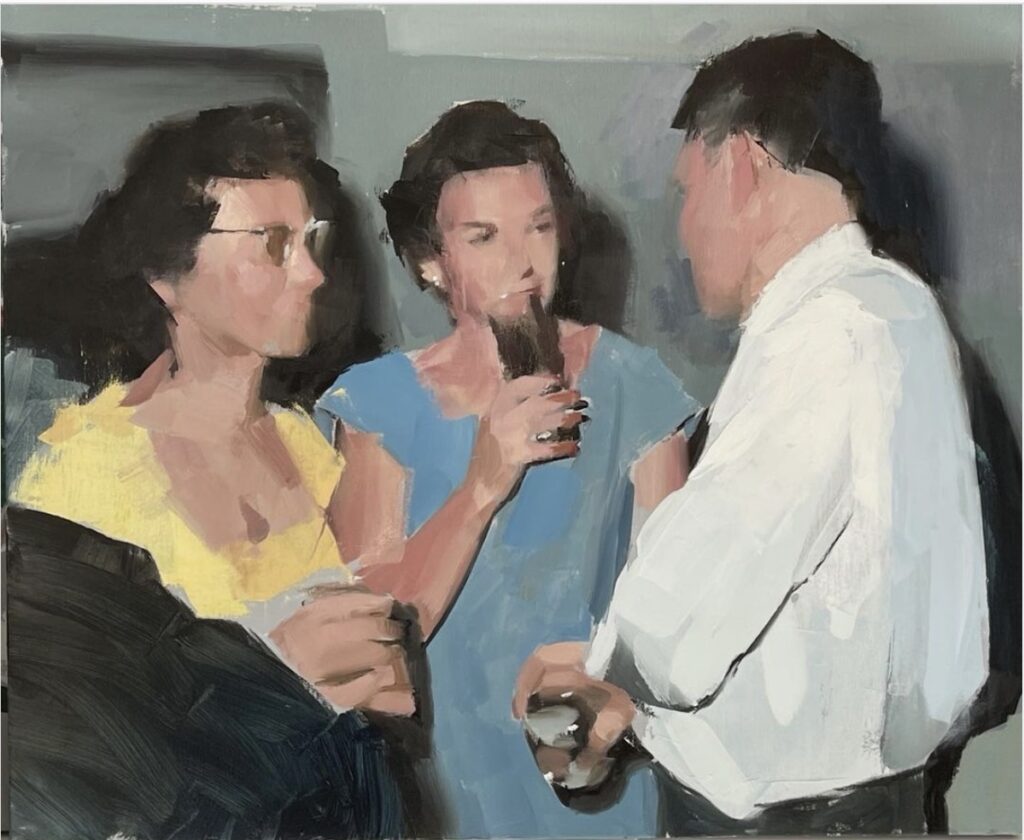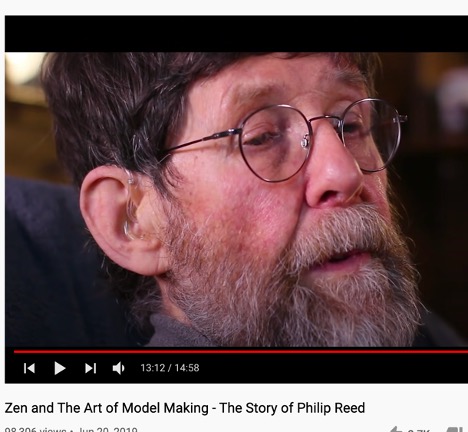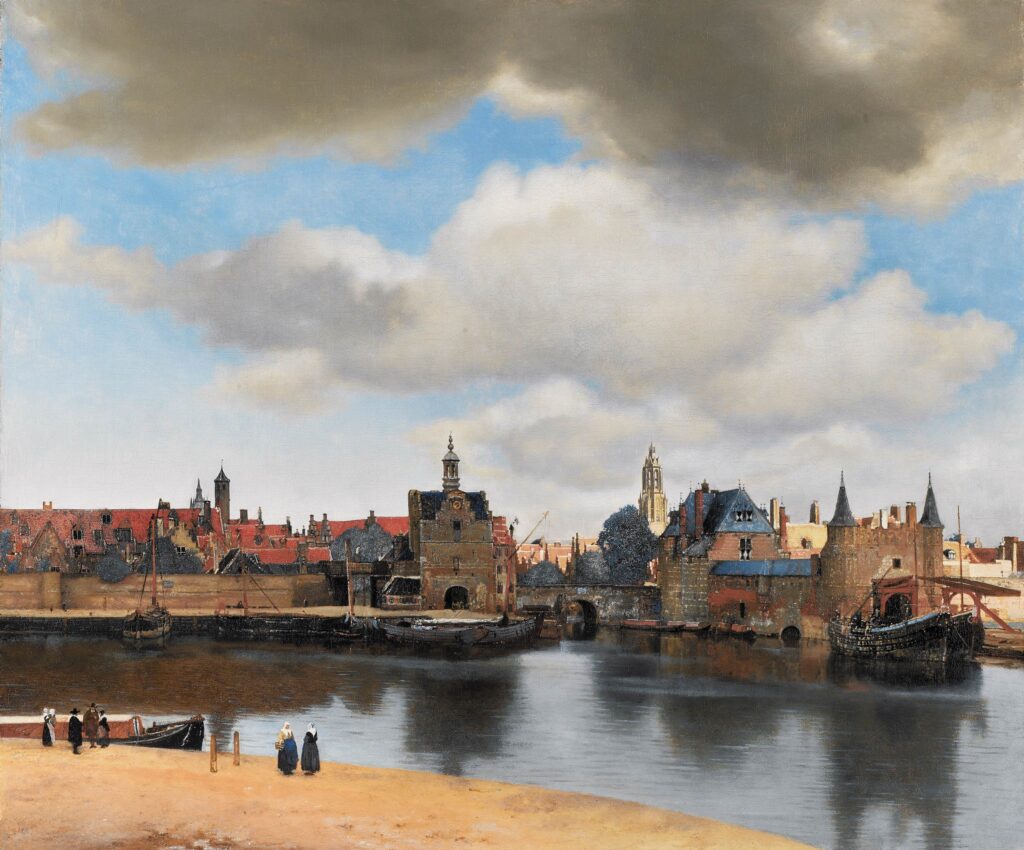Archive for April, 2021
April 29th, 2021 by dave dorsey

Bartlett Pears, 12″ x 16″, oil on linen
My life the past two years has toggled between slow-burning family emergencies punctuated by intervals of regular, predictable daily hours of painting. The crises have morphed into ongoing obligations to care for family members who need assistance, but this is a shift toward regularity that allows me to restore the concentrated, monotonous, repetitive attention essential for painting. I’m finally emerging from unpredictable interruptions and, if I’m lucky, I’m hoping I can look forward to quite a few years of being able to put in significant daily hours of work. It’s what I need to finish a suite of paintings I started more than two years ago: images of salt-water taffy I haven’t been posting because I want to complete most of the whole series in order to decide what to put on view. I’ve completed only ten of these paintings so far—even the smaller ones have taken four to six weeks, with six weeks as the average for painting the largest of them. Even at that deliberate rate, I should have completed far more than ten, but for the entire summer two years ago while providing care for my father I was unable to sit at the easel and then I had several months helping my brother get my mom’s life in order in his absence. Then my son and daughter-in-law left California to stay here in Rochester during the pandemic, finally deciding to actually move here when Laura realized she could work remotely as a video producer—which Matthew may be able to do as well once they hire help for childcare. A freak automobile accident created a situation similar to what we faced with my father two years ago—but Laura eventually recovered enough for them to buy and move into a home a mile away. And then she had a baby, their second son. Her recovery and the new grandchild are a blessing, but also—in a wonderful way—it has provided fresh excuses to do things other than paint. All of this has prompted me to go dormant for periods on Instagram and this blog, still working pretty diligently, but not communicating much about what I’ve been doing. MORE
April 24th, 2021 by dave dorsey

Mark Tennant, untitled from Instagram
Mark Tennant ought to be understood as one of the perceptual painters, but he doesn’t really adhere to any of the half dozen implicit rules the hardcore members of that group observe: the delicate balance between flatness and the illusion of depth; the preference for middle values, the slight fetish for letting one’s process show through a palimpsest effect that, for example, allows the viewer to see pencil lines through thin layers of paint or ghosts of earlier and abandoned shapes; their willingness to repeatedly rework a surface, groping toward a final resolution; a preference for middle values; and a general avoidance of photography. Tennant doesn’t adhere much to any of this, but his work shows random glimpses of mundane life in a way that works as both representation and almost gestural abstraction, which seems the prime directive for most perceptual painters. Tennant always works, it seems, from snapshots. His paintings seem intensely immediate and present—an impression of human motion frozen by an explosion of light. The work of the perceptual painters seems closer to the indeterminacy of memory, its slightly faded moodiness, than to the crisp detail of what greets the eye here and now. Tennant’s work oddly toggles between past and present, but it seems to make the past look contemporaneous, rather than the other way around. The look of a snapshot evokes the past, by definition, but what you see in one of his paintings seems alive and ready to move, something that caught your eye fifteen minutes ago. He loves the baleful glare of flash photography and the way it gives relief to figures, nudging them toward the viewer by coating them with dark outlines, penumbras of visible shadow that often seem, by some inexplicable leap, to hint at moral decline.
What’s so remarkable about his paint is the way it looks fresh, spontaneous, alla prima, and yet so astonishingly accurate—each little painting is like a visual haiku, the scene reduced to the fewest possible descriptive details, a face nothing but spots of color with three tiny marks to indicate eyes and nose, no need to even indicate a mouth. But nothing looks all that worked over: he’s giving you just what’s there, minus all the information you simply don’t need. That’s classic painting, but it feels, in his hands, like something fresh and unfamiliar. (And that’s great painting.) So simply executed, yet that little face of the woman in the center of her cocktail party chatter, that visage the size of a fingerprint, would be instantly recognizable to anyone who knew her, whoever she is. How is that possible? The eyes—like the tiny eyes in a very small El Greco I saw in New York years ago—convey a whole world of personality and experience, a soul. But Tennant has nothing else in common with the Greek. There’s no transcendence here, just that unforgiving flash of light and the darkness it only briefly penetrates. At first, his brushwork seems to descend from Matisse and Porter, looking loose and bold, everything quick as a sketch. But he’s intensely accurate, and his sensibility is brooding and ironic. His process may be much slower than it looks, so the painterly effect probably goes back more to Manet and Sargent, where you have a sense of mastery closer to Velasquez than the Impressionists, and they share Tennant’s vision of how metropolitan sophistication draws some of its energy from decadence. Matisse and Porter use color and tone for their own sake, presenting the joy of natural light just as it is, reaching out and embracing the world with love and appreciation; Tennant inhabits a spiritual world as distant from theirs as Alaska is from Africa. Perhaps what continues to awe me with the work he posts is how much it has evolved and crossed some kind of qualitative border late in his career into this recent mastery. Decades of work leading to the alchemy of this transformation after so much effort: Porter crossed that border too in his last decade. You can see something similar happening as well in the work of some other painters, like Stuart Shils, on Instagram. It’s marvelous.
April 20th, 2021 by dave dorsey

There’s a nice video on YouTube about Philip Reed, a professional model builder: “a man who has committed his life to his craft; a lifetime of scrutinising detail, obsession, perfectionism, and in the end, something truly beautiful.” The short film is more reverential than instructive, if you want to know how he actually does what he does, but some of his comments in the video certainly resonate:
I remember Gerald Cooper, a very renowned painter. One day he just stood and looked at us for a while. He said, “I’m going to tell you the secret to happiness. Get up every morning and paint a flower before breakfast.” That is what he loved to do. So the first thing he did in the morning was that which he loved.
I think of them as three-dimensional paintings.
There are many times when little is achieved. There is frustrating research to be carried out and dead times when nothing seems to move forward. But then there are many others when the work just flows and you enter a very quiet space. Time passes effortlessly.
I go through very dark times sometimes. A recent model I’ve been building, every day has been struggle. It’s difficult. I need focus. The work is very fine. I don’t want to be there. But if you keep going you discover something new and suddenly it’s as if the sun’s come out and I’m loving what I’m doing again.
There are moments of excitement and pleasure when you start to see it come together. If you can get the tone, the color, and everything blend together, that final stage, working through it, is a joy.
Engaging in creative work can be, at its best, a mystical experience. I don’t know what is behind the creation of art. It’s something innate in man. It’s one of the profound mysteries in human life: creative work and art.
April 16th, 2021 by dave dorsey

Four Figs, Two Swans, and Pair of Scissors, 2017, oil on linen, 10.125 x 10″
Matt Klos invited me to sit in on a group Zoom last week with Susan Jane Walp, hosted by Klos and Candice Hill, who teaches in the English Department at Anne Arundel Community College, where Matt teaches painting. Walp has a quiet, distinguished career, living in Vermont, studying Tibetan Buddhism and painting and doing little else, having moved there from Soho where she worked in the 80s. It was a long, interesting conversation partly because so much of it felt attenuated by Walp’s difficulty in putting the most essential elements of what she does into words. That’s refreshing, a person of few words in an era where we live under a tsunami of social media inanity. A lot of the discussion was about a series of improvisational paintings she’s done as a meditation on the loss of her husband six years ago, paintings that somehow remind me of Jung’s The Red Book images, not in form but in spirit—as if she has been sketching emotional and spiritual archetypes drawn from her own subconscious. These are quite different from her core work in still life. What I found most useful was the discussion of these still lifes on linen.
The most interesting questions and answers were on how her work in oil resolves itself into something she considers finished; how she manages to keep the process feeling alive and risky after investing long days and weeks or months into a given painting; and what her primary considerations are, the core values, she tries to observe in the process of making a painting.
This last issue was very appropriate to this particular conversation, because Candice Hill specializes in lyric poetry with a focus on Emily Dickinson and found many parallels between Dickinson’s sidelong, elliptical poetry and Walp’s spare, improvisational watercolors. Walp has said she draws inspiration from Dickinson’s poems, their paradoxical sense of scale, particularly in Dickinson’s ability to evoke cosmic truth through such a tiny pillar of words on the page. That use of scale links her with Dickinson: the leverage involved in using something small to evoke something big. Walp’s paintings feel in some ways even smaller than Dickinson’s gnomic lines. Walp said: “Even in these paintings that are quite small, eight inches by eight inches, if that relationship becomes accurate (between the precise detail and the more indefinite lines of larger areas), I feel there’s something big about the painting.” Given this indebtedness to poetry, it wasn’t shocking that Walp cited Elizabeth Bishop, who was a serious painter as well as a uniquely great poet, as someone who perfectly articulated the three qualities creative work must have. Bishop said every poem needs to be accurate, spontaneous, and mysterious. Walp wants her paintings to hew to those rules.
There is a tremendous tension implicit in those first two qualities. How to be both improvisational and accurate seems to be a core competency for perceptual painters in general and a difficult tightrope to walk for any painter. (Fairfield Porter managed to balance accuracy and spontaneity perfectly again and again toward the end of his career, but Walp’s work doesn’t owe much to the way Porter handled paint, except in a few instances.)
Walp said: “In Dickinson the thing that has struck me in my non-scholarly reading of her work is the way that she can go from some very almost microcosmic detail to just the macrocosm. This idea of scale; how there can be an infinite space in such a physically small poem. That’s something I aspire to certainly in the still lifes . . . Bishop’s . . . three criteria for evaluating poems: accuracy, spontaneity and mystery. I’ve spent a lot of time working on the spontaneity. The mystery is divine grace. It’s given to you in certain work.” MORE
April 5th, 2021 by dave dorsey

The Garden of Earthly Delights, Agnieszka Nienartowicz
The ultimate tramp stamp. Amazing work from a young Polish artist, evoking both Bosch and Richter, with a cautionary twist to the allure it conveys.
April 1st, 2021 by dave dorsey

Vermeer’s “View of Delft”
I find it encouraging that the greatest philosopher and the greatest novelist of the 20th century agreed about some fundamental, crucial things, at about the same time, early in the century. It seems everyone else except maybe T.S. Eliot were heading in the opposite direction—Nietzsche a bit earlier, the modernists in art, Einstein in physics, Freud in his field, Marx in economics and politics–all of them striving to destabilize the values and norms of the Western world. Meanwhile, Wittgenstein and Proust were suggesting that the most fundamental realities hadn’t changed at all and would never change, even though many didn’t understand this about the philosopher, and it this isn’t immediately obvious in Proust, given the structure of his virtually plotless novel, a tapestry of interwoven stories that evolve almost imperceptibly toward his majestic renunciation of society in favor of art.
Wittgenstein, whose efforts have been camouflaged by his role as the patron saint of analytical 20th century philosophy, asserted that human values can’t be derived from our experience in the world. They exist outside the world, and thus, in a sense, can’t be analyzed or deduced, but are simply a given, transcendent and immune to rational justification or questioning. They have no utility. They just are. You don’t “adopt” them to make the world a better place (on what grounds would one chose a set of values that give you the rules for calculating which values are best?). Goodness is an unassailable framework within which human purposes evolve and can be understood. Goodness and truth and beauty govern human behavior, as the essential structure of human experience, whether or not an individual is conscious of them or not. In other words, Wittgenstein actually had a metaphysics, about which he forbade himself to talk, because its truth was impossible to prove, hence the famous last line of the Tractatus: “Whereof one cannot speak, one must remain silent.” However, he meditated quite a bit on these values during that silence. He carried around a copy of Tolstoy’s The Gospel in Brief all through his service in World War I, and he relinquished one of the largest inheritances in Europe. He seriously considered becoming a monk at one point. These transcendent values he lived, rather than asserted, because he appeared to consider them impossible to justify through reason or philosophical language. His silence about everything that actually mattered seems, in retrospect, almost uniquely noble and honest.
One finds a similar point of view, an even more Platonic one, from Marcel Proust in A La Recherche du Temps Perdu, written during the years Wittgenstein wrote his Tractatus, about the death of Proust’s fictional novelist, Bergotte. In The Captive, he talks about the role of the creative imagination, in painting and fiction and music. These thoughts precede one of the great revelatory moments in the story, when Morel’s musical performance triggers for the narrator a crucial moment of enlightenment about the nature of art. (It is typical of Proust that Morel is one of his few genuinely evil characters, the embodiment of sadistic cruelty, yet he is also, despite his depravity, a rare musical genius, one of God’s messengers, as it were, through the medium of the violin.) This passage makes Proust’s narrator sound a bit like a Cathar or a Buddhist, but his essential point is that human beings don’t pick and choose their “values;” those values precede and ground all human choices and behavior, and people spend their lives struggling to simply see them and exemplify them as directly as possible, to live “beneath the sway of those unknown laws”—an achievement that is, like a great golf swing or a sumi-e painting—both unconscious and ego-less, almost automatic, when done perfectly, and yet immensely difficult to “get right”:
He was dead. Dead forever? Who can say? . . . All that we can say is that everything is arranged in this life as though we entered it carrying a burden of obligations contracted in a former life; there is no reason inherent in the conditions of life on this earth that can make us consider ourselves obliged to do good, to be kind and thoughtful, even to be polite, nor for an atheist artist to consider himself obliged to begin over again a score of times a piece of work the admiration aroused by which will matter little to his worm-eaten body, like the patch of yellow wall painted with so much skill and refinement by an artist destined to be forever unknown and barely identified under the name Vermeer. All these obligations, which have no sanction in our present life, seem to belong to a different world, a world based on kindness, scrupulousness, self-sacrifice, a world entirely different from this one and which we leave in order to be born on this earth, before perhaps returning there to live once again beneath the sway of those unknown laws which we obeyed because we bore their precepts in our hearts, not knowing whose hand had traced them there—those laws to which every profound work of the intellect brings us nearer and which are invisible only—if then!—to fools. So the idea that Bergotte was not permanently dead is by no means improbable.
–The Captive





